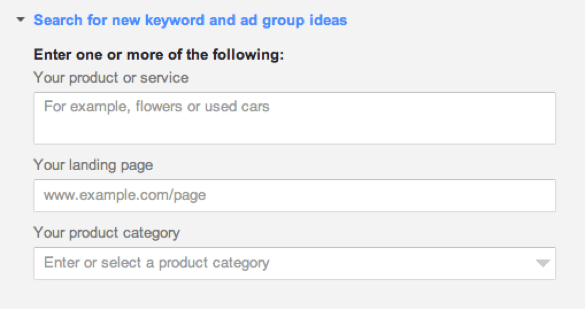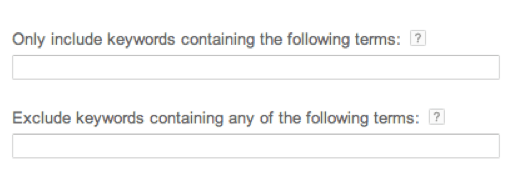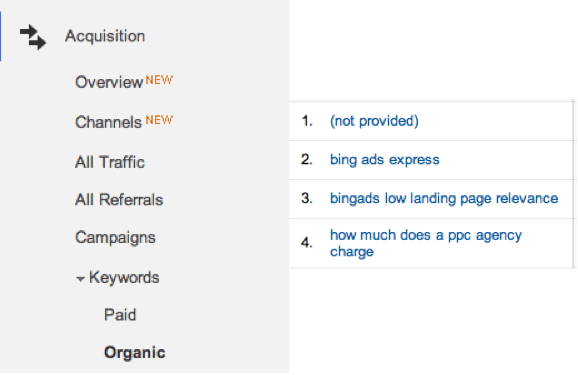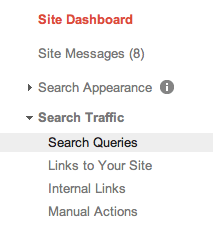PPC advertisers are constantly looking for long tail keywords because they are more likely to generate quality clicks at a lower CPC than more general and extremely competitive keywords. For example, “buy an affordable black dress online” versus the more general (and expensive) “women’s black dress” or “women’s clothing”. But how do you find valuable long tail keywords? Below are some best practices for identifying long tail keywords for accounts of all sizes.
Use The Search Box on Google.com
This is the simplest and most effective way to generate long tail keywords. Simply go to Google.com and starting a search with a term you related to your business or market. Google will start suggesting search terms, just like it does for real searchers. These are terms that you should consider targeting because it is likely that google users will use them to search for your product or service.
 Source: Google.com
Source: Google.comAs you can see in the image above, Google is suggesting terms based on what people use to look for. Scale this approach to your business type and you will find a lot of long tail keywords. These keywords do not necessarily have high search volume, but their quality is definitely higher than general keywords.
Check Your Search Query Report
The search query report is a great resource. It is a list of search terms your site showed up for thanks to your broad, phrase, and broad match modified keywords. You can use the search query report to spot long tail terms that converted or that have a good amount of clicks to leverage. You can access the search query report for the keywords in a campaign or an AdGroup. You can also access it at a per keyword level if the keyword has enough traffic. You can access a search query report clicking on the keyword s tab and then on Details. You can now select “selected” or “all” depending on whether you want to analyze the search terms of a group of keywords or for the whole account.
 Source: Google AdWords Interface
Source: Google AdWords InterfaceUse The Keyword Tool & Leverage Include & Exclude Keywords Function
The keywords tool has been improved a lot over the past few months and is actually very useful to find new long tail keywords. It is very important to use the correct settings to use the tool effectively. First, include a few terms to base your research on.
 Source: Google AdWords Keywords Tool
Source: Google AdWords Keywords ToolSecond, make sure to exclude every term that you do not want in your long tail keywords. This will help Google to exclude all irrelevant suggestions. Also, do not forget to include any word you absolutely want in your long tail keywords.
 Source: Google AdWords Keywords Tool
Source: Google AdWords Keywords ToolGoogle will now generate a lot of new keywords ideas for you. Not all of them will be relevant, but it is a great way to discover new long tail keywords.
Check The Organic Terms You Rank For
You can find tons of ideas by looking at organic traffic coming to your website. Organic traffic is highly competitive, which means the keywords you rank for are long tail gold. You can compile a list of these long tail keywords, create variations of them, and then add them to your keywords list on AdWords.
 Source: Google Analytics Interface
Source: Google Analytics InterfaceAnother great tool to retrieve organic keywords is the webmaster tool. Just log in to the webmaster tool and select the website you want to work on. A menu on the left side column will open. You can see your search queries by clicking on search traffic, and then on search queries:
 Source: Google Webmaster Tool
Source: Google Webmaster Tool
Think Like a Local User
Many local searches could be very profitable but are often ignored because Google tells us they are not often searched. However, local people tend to look for local services using the city/town name. This makes it very important for you to start thinking like a local customer and understand what long tail geo targeted keywords can bring it the most revenue. This technique is not often used by advertisers because it might generate a lot of low-search volume keywords. However, you should still consider this strategy if you are targeting one or more niche geographic areas — don’t forget to create one at least one AdGroup per geographic area.
Use The Keyword Tool to Run Your Competitors’ URLs
Whenever you run a website through the keyword tool, you will get a list of keywords that Google considers good for that particular website. You might come across terms you did not think of. This method has the advantage of helping you figure out long tail keywords related to the topic of a business, but it tends to suggest slightly more expensive keywords than you would normally expect from a long tail.
Use Third-Party Tools to Get Inspired
Look to third-party software and tools for new long tail keywords. There are many free tools out there, while others will need to be paid for. Depending on the size of your account and your experience with these tools, it might be worth testing.
In Conclusion
There is no question that keywords are one of the most important elements of any advertising account. A great optimization strategy should also include the research of long tail keywords in order to bring more qualified traffic, resulting in a higher ROI.
What other techniques do you use to find long tail keywords? Share it with us in the comments below!





